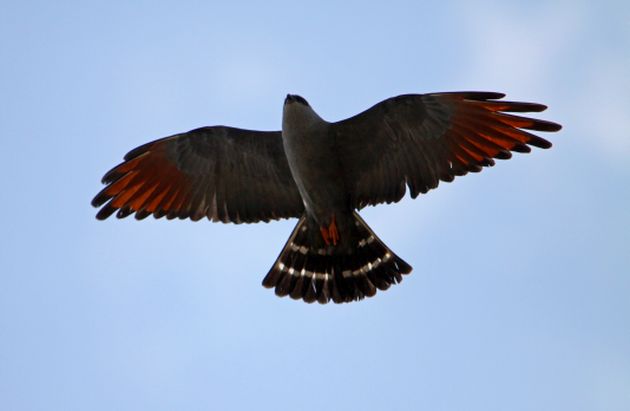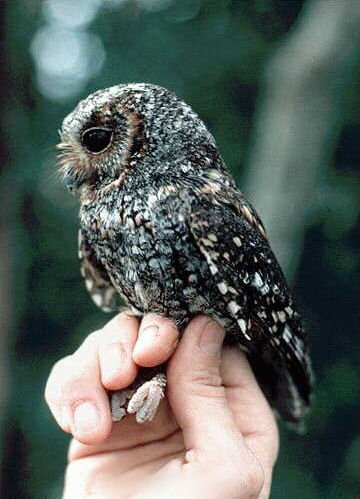
Last week I had the privilege of taking a group of Queens middle-schoolers birding in Forest Park as part of an after-school program. We practiced using binoculars and field guides, talked about migration and how important New York’s parks are in providing habitat for exhausted birds, I even worked in a plug for keeping cats indoors. Then we looked for some common species.
By far the most popular bird we saw was the Red-winged Blackbird. This is partly because they were easy to spot and making a lot of noise, and partly because they’re very beautiful birds, but also, I think, partly because the name matches what the kids were seeing so well. Red-winged Blackbird is easy to understand and easy to remember.
A descriptive name is almost always, in my book, better than an arbitrary geographic designation or the name of some colonizing johnny-come-lately (with all due respect to Mr. Wilson.) But not all birds are as amenable to a straight-ahead description as the Red-winged Blackbird, and not all adjectives are as commonplace as ‘red’ and ‘black’. Take the soon-to-be-lamented Hoary Redpoll. ‘Hoary’, as a synonym for pale or grayish-white, was once a common descriptor but its use over time has declined significantly. It seems to be entering the realm where only birders and crossword-puzzle aficionados will know it. And should there be a lump, maybe only the crossword-puzzle nerds and birders in Australia, where you can find the Hoary-headed Grebe.
Some of my other favorite obscure bird adjectives:
Plumbeous, meaning lead-colored. A surprisingly pretty name for a color that, on a bird, can look surprisingly pretty. Also surprisingly common – we’ve got Plumbeous Vireo, Warbler, Ibis, Kite, Antbird, Seedeater, Forest-falcon, and Water Redstart. And, of course, the Semiplumbeous Hawk.
Cinereous, meaning brownish gray. You can never have too many shades of gray – this, not sex or terrible writing, is what makes the work of E. L. James so popular. Cinereous Tit, Cinereous Bunting, and Cinereous Vulture all bear this standard, but perhaps the most popular cinereous bird on the internet is the Cinereous Mourner, with its clever and adorable chicks.
Flammulated, speaking of adorable, means “with flame-shaped markings” but to me sounds like it might describe the mental state of Muppets – a combination of flummoxed and animated, or perhaps of flailing and animated, but anyway, definitely that thing that Kermit the Frog does. A lot of owls look kind of like Muppets when they’re young, but there is only one Flammulated Owl.
Ferruginous, meaning rust-colored. In North America best known as the name of a hawk that comes in different color morphs, but it also applies to the Ferruginous Duck, which is notably rusty only in the male’s plumage. This points up one of the problems with descriptive naming. The Ferruginous Pygmy-owl is pretty much always rusty, though.
Fulvous, meaning reddish-brownish-yellowish. Reddish-brownish-yellowish Whistling Duck or Reddish-brownish-yellowish Babbler would be silly names for a bird.
Reddish-brownish-yellowish-grayish Sparrow or Reddish-brownish-yellowish-grayish Thrush would also be silly names for a bird, but somehow Clay-colored isn’t? Clay-colored gets an honorable mention on my list because it seems straightforward, ok, clay-colored, everyone knows what clay is, and colors. But when you come right down to it, different deposits of clay are different colors, and the Clay-colored Sparrow is a completely different shade of brown than the Clay-colored Thrush. Plus a lot of other sparrows and thrushes are also shades of brown that could be described as clay-colored, depending on the clay. I begin to see the appeal of just throwing up your hands and naming your new bird the Eastern Laben’s Duck or what have you.
Flammulated Owl courtesy of the US Geological Survey. Plumbeous Kite copyright Vil_Sandi, used under a Creative Commons license.














Lovely post, love these shades of brown and gray.
“50 shades of cinereous”. Sigh. Such a missed chance.
A lovely post, one of your best – and that’s saying something.